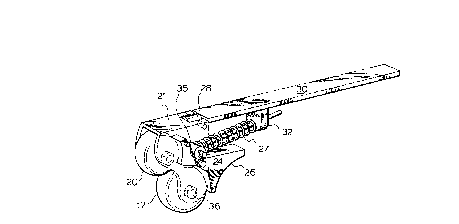Some of the information on this Web page has been provided by external sources. The Government of Canada is not responsible for the accuracy, reliability or currency of the information supplied by external sources. Users wishing to rely upon this information should consult directly with the source of the information. Content provided by external sources is not subject to official languages, privacy and accessibility requirements.
Any discrepancies in the text and image of the Claims and Abstract are due to differing posting times. Text of the Claims and Abstract are posted:
| (12) Patent: | (11) CA 2074587 |
|---|---|
| (54) English Title: | FRONT WHEEL BRAKE FOR TANDEM WHEELED ROLLER SKATE |
| (54) French Title: | FREINS AVANT POUR PATINS A ROULETTES EN TANDEM |
| Status: | Expired and beyond the Period of Reversal |
| (51) International Patent Classification (IPC): |
|
|---|---|
| (72) Inventors : |
|
| (73) Owners : |
|
| (71) Applicants : |
|
| (74) Agent: | DENNISON ASSOCIATES |
| (74) Associate agent: | |
| (45) Issued: | 1997-12-02 |
| (22) Filed Date: | 1992-07-24 |
| (41) Open to Public Inspection: | 1994-01-25 |
| Examination requested: | 1993-12-13 |
| Availability of licence: | N/A |
| Dedicated to the Public: | N/A |
| (25) Language of filing: | English |
| Patent Cooperation Treaty (PCT): | No |
|---|
| (30) Application Priority Data: | None |
|---|
A roller skate with a plurality of skate rollers
including a front roller has a front end brake comprising a
brake wheel forwardly of the front roller with a braking
member between the brake wheel and the front roller. The
brake wheel has a lower reach above that of the front
roller when the skate is in the rolling position on the
rollers and the brake wheel in a brake released position.
The brake wheel is movable rearwardly so that its periphery
is against the brake member in a braking position when the
skate is tipped forwardly away from the rolling position
onto the brake wheel. A spring is provided which moves the
brake wheel back to the brake released position when the
skate is returned to the rolling position.
Patin à roulette comprenant une série de roues, y compris une roue avant munie d'un frein avant constitué d'une roue de freinage située devant la roue avant et d'un dispositif de freinage placé entre la roue de freinage et la roue avant. La roue de freinage n'a pas la même portée que la roue avant étant donné qu'elle se situe au-dessus de cette dernière lorsque le patin est en position de roulement et repose sur toutes ses roues et que la roue de freinage est en position de repos. La roue de freinage peut se déplacer vers l'arrière, de sorte qu'en position de freinage, lorsque le patin est incliné vers l'avant, hors de sa position de roulement, et s'appuie sur la roue de freinage, cette dernière se déplace vers l'arrière afin d'entrer en contact avec le dispositif de freinage. La présente invention prévoit un ressort pour remettre la roue de freinage en position de repos une fois que le patin est de nouveau en position de roulement.
Note: Claims are shown in the official language in which they were submitted.
Note: Descriptions are shown in the official language in which they were submitted.

2024-08-01:As part of the Next Generation Patents (NGP) transition, the Canadian Patents Database (CPD) now contains a more detailed Event History, which replicates the Event Log of our new back-office solution.
Please note that "Inactive:" events refers to events no longer in use in our new back-office solution.
For a clearer understanding of the status of the application/patent presented on this page, the site Disclaimer , as well as the definitions for Patent , Event History , Maintenance Fee and Payment History should be consulted.
| Description | Date |
|---|---|
| Time Limit for Reversal Expired | 2000-07-24 |
| Letter Sent | 1999-07-26 |
| Grant by Issuance | 1997-12-02 |
| Inactive: Application prosecuted on TS as of Log entry date | 1997-09-24 |
| Inactive: Status info is complete as of Log entry date | 1997-09-24 |
| Pre-grant | 1997-07-25 |
| Notice of Allowance is Issued | 1997-01-28 |
| Application Published (Open to Public Inspection) | 1994-01-25 |
| All Requirements for Examination Determined Compliant | 1993-12-13 |
| Request for Examination Requirements Determined Compliant | 1993-12-13 |
There is no abandonment history.
The last payment was received on 1997-07-22
Note : If the full payment has not been received on or before the date indicated, a further fee may be required which may be one of the following
Patent fees are adjusted on the 1st of January every year. The amounts above are the current amounts if received by December 31 of the current year.
Please refer to the CIPO
Patent Fees
web page to see all current fee amounts.
| Fee Type | Anniversary Year | Due Date | Paid Date |
|---|---|---|---|
| MF (application, 5th anniv.) - small | 05 | 1997-07-24 | 1997-07-22 |
| Final fee - small | 1997-07-25 | ||
| MF (patent, 6th anniv.) - small | 1998-07-24 | 1998-07-21 |
Note: Records showing the ownership history in alphabetical order.
| Current Owners on Record |
|---|
| MARIO DE SANTIS |
| Past Owners on Record |
|---|
| None |